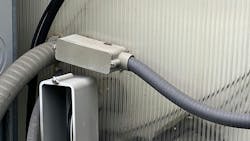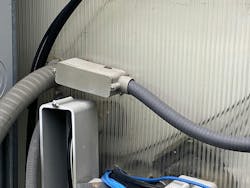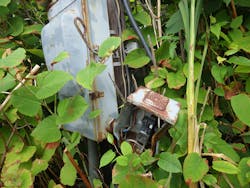All references are based on the 2023 edition of the NEC.
Mismatched Wiring Methods
The first violation I want to point out here is the missing cover on the larger of the two conduit bodies. Section 314.25 requires conduit body enclosures to be installed with a cover, lampholder, or device. The next violation is the liquidtight flexible nonmetallic conduit (LFNC) used with the smaller rigid PVC conduit body. The second sentence of
Sec. 300.15 requires fittings and connectors to “be used only with the specific wiring methods for which they are designed and listed.” Rigid PVC conduit bodies are not listed for use with LFNC. These mismatched wiring methods are also a violation of Sec. 110.3(B) because they are not installed and used in accordance with their instructions.
I would like to point out that certain wiring methods can be used with fittings designed and listed for use with other wiring methods. One example of this is using electrical nonmetallic tubing (ENT) with rigid PVC conduit fittings. ENT and rigid PVC conduit are made of the same materials. Using rigid PVC conduit fittings with ENT is generally permitted, provided installers use the correct type of ENT solvent cement (aka glue). ENT cement applicators are typically a brush while PVC cement applicators are typically a dauber type.
Danger Lurking in the Brush
I spotted this dangerous situation in the far corner of a parking lot in a beachside community. I’m surmising this equipment was accidentally hit and damaged by a vehicle, since there are no protective bollards or guardrails installed to prevent this very type of damage. Where electrical equipment is installed in areas likely to be exposed to physical damage, Sec. 110.27(B) requires enclosures or guards to be “arranged and of such strength as to prevent such damage.” That Code requirement was apparently overlooked for this parking lot installation, and the photo shows the results of what can happen when Code rules are ignored. A 4,000-lb vehicle bumping into a panelboard enclosure or other electrical enclosure can easily cause catastrophic damage to the electrical equipment. With the cover missing off the smaller disconnect, the energized parts are now exposed, posing a severe shock hazard while creating a violation of Sec. 110.27.
The broken and damaged equipment is also a violation of Sec. 110.12(B), making it no longer safe to remain in operation. This broken equipment needs to be replaced, and protective guards, such as curbs, bollards, or guardrails, need to be installed to prevent a repeat of this situation.
About the Author

Russ LeBlanc
Owner
Russ started in the electrical trade as an apprentice in 1985. He worked his way up to become a Journeyman Electrician and then eventually became a Master Electrician and Licensed Construction Supervisor. In 1999 Russ become an Electrical Instructor for The Peterson School of Engineering in Massachusetts where he developed his passion for teaching, and quickly became Department Head of Electrical Instruction. Russ has taught thousands of apprentices, electricians, engineers, inspectors, and other electrical professionals during his career as an instructor. He continues to provide electrical professionals with Electrical Code seminars, Arc-Flash Awareness training seminars and educational material through his LeBlanc Consulting Services in North Reading, MA whose specialty is educating electricians. He has been an active member of the NFPA Electrical Section and has authored hundreds of National Electrical Code proposals and comments which have become Code rules to improve the safety for the electrical industry. Russ is also an IAEI certified Electrical Inspector.
Please visit www.russleblanc.net for more information.


